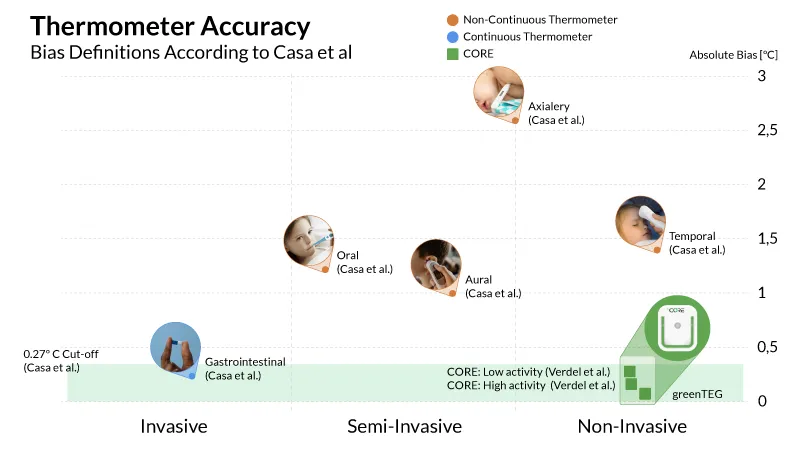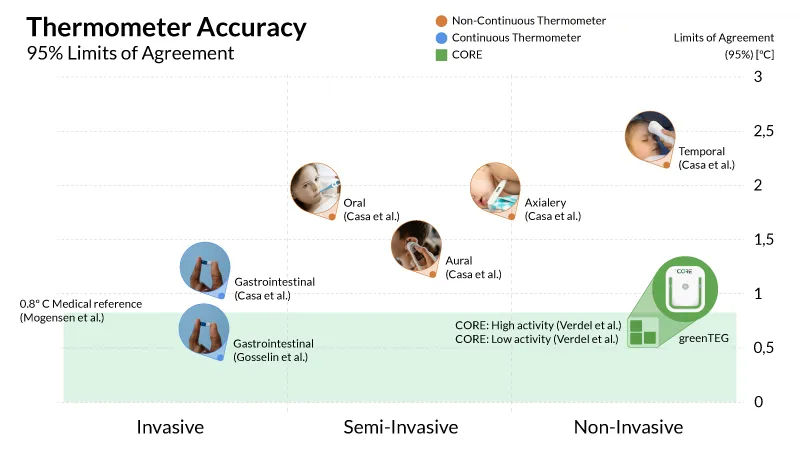Public Statement
Public Statement | CORE Accuracy for Sports
This page gathers all the public statements regarding greenteg and CORE body temperature monitor.
About CORE & greenteg
greenteg created the CORE venture in 2019 to launch the CORE body temperature sensor device in the following year.
Summary
CORE is a new device which helps athletes improve their performance both in heat and under normal conditions by monitoring core body temperature during training and competition. greenteg has done extensive internal validations under many conditions with tens of thousands of hours of measurements. Now, the first independent study has been published by N. Verdel, T. Podlogar and their colleagues. The study shows the CORE sensor has an exceptional repeatability of only 0.02 °C. Repeatability is one of the most important properties for sports training and competition.
In two studies including 12 male athletes, the authors have shown an accuracy in bias of 0.23 °C and -0.1°C and a 95% limit of agreement of 0.55 °C and 0.61°C for moderate and high activity respectively. The accuracy of the bias is below the cut-off of 0.3°C, which was chosen arbitrarily by the authors (ie. it has no clear relation to the use case). This arbitrary cut-off led them to the misleading conclusion that the CORE sensor does not provide a valid measure of core body temperature. However, the limit of agreement is in the same range as medical ear thermometers used under steady-state conditions in hospitals. This is acknowledged by the authors themselves: “Compared to the data published by Ganio et al., the CORE sensor has proven to be more accurate than other non-invasive devices (i.e.,devices to assess forehead, oral, temporal, aural, and axillary) used in sports”.
With our expertise in heat training and heat acclimatization - developed together with coaches of world-class cycling, running and triathlon teams - we see the repeatability and accuracy of CORE (as validated by Verdel et al) as valuable for improving sports performance. This belief is supported by many coaches and professional athletes who understand how to interpret the data of Verdel correctly and who continue to use CORE for their everyday training
Definition of the use case
CORE Body Temperature Monitoring technology has been developed, tested, refined, and improved in an ongoing process over the past seven years. The algorithms are based on tens of thousands of hours of data collected by test subjects using ingestible e-pills under various sports and free-living conditions.
An algorithm was developed for the following use cases:
- Improving sports performance for cyclists and runners
- Fever detection
- Free living (eg circadian cycle detection)
How temperature rises, maintains, and decreases during sports and heat exposure is very individual. Prior to CORE, it was only possible to measure core body temperature with invasive temperature measurement methods such as swallowing an expensive electronic temperature pill (e-pill) every day. Professional athletes and coaches were seeking an everyday non-invasive method to measure the core body temperature with an accuracy level acceptable for the sports performance use case.
Definition of the accuracy level for the use case
The usefulness of a temperature measuring method is based on the device’s repeatability and its accuracy.
Repeatability
Repeatability is the deviation of the data outputs when a test is repeated with the same person under the same conditions. Repeatability is very important for the use case.
Accuracy
The accuracy is usually defined as the deviation of the measurement from a reference and is given in several numbers:
- Bias gives the average deviation from all the measured data points to the reference (it is mainly defining an offset to the reference).
- Mean absolute deviation (MAD) is the absolute average deviation from all the data points to the reference (here +/- deviation do not cancel each other out, as in bias)
- Standard deviation and 95% interval (limit of agreement / two times the standard deviation) shows the deviation band where 68% to 95% of all the data points are included.
For medical certification in clinical trials, the 95% interval is the most important number to describe accuracy. Well elaborated accuracy cut-off values for sports performance do not exist. We believe that the accuracy of a clinical fever thermometer (eg. an ear thermometer used in a controlled hospital environment) should also be suitable for the sports use case. The accuracy of clinical fever thermometers for the ear are well investigated. Their 95% limit of agreement intervals range from 0.53 °C [1] to 0.8 °C [2] depending on the study and the user.
Validation of the accuracy for the sports use case
Currently only one scientific paper has validated the accuracy of CORE in the sports use case (Verdel and Podlogar et al [3]). The validation test was performed with 12 male participants on indoor bike trainers at moderate and elevated humidity and temperature. The paper tested only this one very particular “case”. Other situations like running or cycling outdoors, running indoors, and other subject phenotypes such as females and various age groups were not evaluated.
The Verdel et al study used a rectal probe for reference. It is known that measurements from the rectal probe deviate from the e-pill (used for reference by greenteg) and the pulmonary heart catheter [4].
Repeatability
Verdel et al [3] have shown that the repeatability of the CORE device under the given condition is exceptionally good , with a mean bias of only 0.02°C. In other words, the CORE output for a single person is very repeatable when conducting the same test with the same person. This means CORE can be used for training improvement, but each individual needs to find out his/her own optimal training and heat limitation zones. These may differ from person to person (due to CORE, but also due to different body physiology).
Accuracy
As mentioned above, the bias and the 95% limit of agreement are important for accuracy. Verdel et al. [3] has performed two different studies – one with high activity and one with moderate activity . Table 1 shows the results according to these two protocols.

The two figures below show the bias and the 95% limit of agreement in comparison to other invasive and non-invasive devices. Most of the data are retrieved from Casa et al [5] and Gosselin et al [6]. Verdel et al [3] chose the cut-off value for proper heat stroke detection on the bias based on Casa et al, who defined it as 0.5 °F (0.27 °C) as a value easy to remember by health personnel. (This value is neither related to the use case of improving sports performance nor to heat stroke detection. It is just randomly chosen which in our option is not very scientific. Nevertheless, we have also used it in the graphic.)
A cut-off for the 95% limit of agreement was not defined by Casa et al. However, for some reason Verdel et al used 0.3 °C, based on the bias cut-off from Casa without any further explanation. In our opinion, a valid cut-off value would be based on the accuracy of clinically approved thermometers, such as the ear thermometer. Therefore, we used 0.8 °C in the graph for this value.


Observations on the accuracy:
- According to the results obtained on both studies by Verdel et al, the bias of the CORE device is below the cut-off value defined by the authors
- The limit of agreement of the CORE device in both studies is better than the limit of agreement of state-of-the-art clinical thermometers used under steady-state settings in hospitals
- The graphics illustrate that CORE is the only thermometer of all the non- and semi-invasive thermometers which accurately detects core body temperature during sports.
Conclusions
Verdel et al have produced a validation study which reaffirms the accuracy of CORE according to the findings of greenteg. It was shown that the repeatability of CORE, which is much more important than accuracy for the sports use case, is exceptionally good at 0.02 °C. Also, the accuracy of CORE, with a bias of 0.23 °C and -0.1 °C, is very good compared to the other non- or semi-invasive methods evaluated for sports. Both values agree with the cut-off value defined by the authors. The 95% limit of agreement of 0.55 °C and 0.61 °C of both protocols are even better than the limit of agreement of clinical ear thermometers under steady state conditions. Based on this, we conclude (despite the authors' claims) that CORE is very well suited for improving sports performance and heat acclimatization. CORE is not a medical device and therefore cannot be used for heatstroke detection. However, when training with CORE, athletes can develop a feeling for their own limitations.
As a side note: The authors' conclusion that CORE does not provide a valid measure of CORE body temperature is not comprehensible . That more than 50% of the values are above a deviation of 0.3 °C is common also in clinical non- and semi-invasive thermometers. This is because temperature at different positions in the body can vary up to 0.4 °C (bias) with limits of agreements up to 1.0 °C during fast temperature changes (as in sports) when measured with the highly accurate invasive methods (rectal and the 'gold standard' pulmonary artery) [7].
Reference
[1] Bock M, Hohlfeld U, von Engeln K, Meier PA, Motsch J, Tasman AJ. The accuracy of a new infrared ear thermometer in patients undergoing cardiac surgery. Can J Anaesth. 2005 Dec;52(10):1083-7. doi: 10.1007/BF03021609. PMID: 16326680.
[2] Mogensen CB, Vilhelmsen MB, Jepsen J, Boye LK, Persson MH, Skyum F. Ear measurement of temperature is only useful for screening for fever in an adult emergency department. BMC Emerg Med. 2018 Dec 3;18(1):51. doi: 10.1186/s12873-018-0202-5. PMID: 30509206; PMCID: PMC6276133.
[3] Verdel, N.; Podlogar, T.; Ciuha, U.; Holmberg, H.-C.; Debevec, T.; Supej, M. Reliability and Validity of the CORE Sensor to Assess Core Body Temperature during Cycling Exercise. Sensors 2021, 21, 5932 doi.org/10.3390/s21175932.
[4] Byrne C, Lim CL. The ingestible telemetric body core temperature sensor: a review of validity and exercise applications. Br J Sports Med. 2007 Mar;41(3):126-33. doi: 10.1136/bjsm.2006.026344. Epub 2006 Dec 18. PMID: 17178778; PMCID: PMC2465229.
[5] Casa DJ, Becker SM, Ganio MS, Brown CM, Yeargin SW, Roti MW, Siegler J, Blowers JA, Glaviano NR, Huggins RA, Armstrong LE, Maresh CM. Validity of devices that assess body temperature during outdoor exercise in the heat. J Athl Train. 2007 Jul-Sep;42(3):333-42. PMID: 18059987; PMCID: PMC1978469
[6] Gosselin, J.; Béliveau, J.; Hamel, M.; Casa, D.; Hosokawa, Y.; Morais, J.A.; Goulet, E.D.B. Wireless Measurement of Rectal Temperature during Exercise: Comparing an Ingestible Thermometric Telemetric Pill Used as a Suppository against a Conventional Rectal Probe. J. Therm. Biol. 2019, 83, 112–118.
[7] J Robinson , J Charlton, R Seal, D Spady, M R Joffres. Oesophageal, rectal, axillary, tympanic and pulmonary artery temperatures during cardiac surgery, Can J Anaesth. 1998 Apr;45(4):317-23. doi: 10.1007/BF03012021.